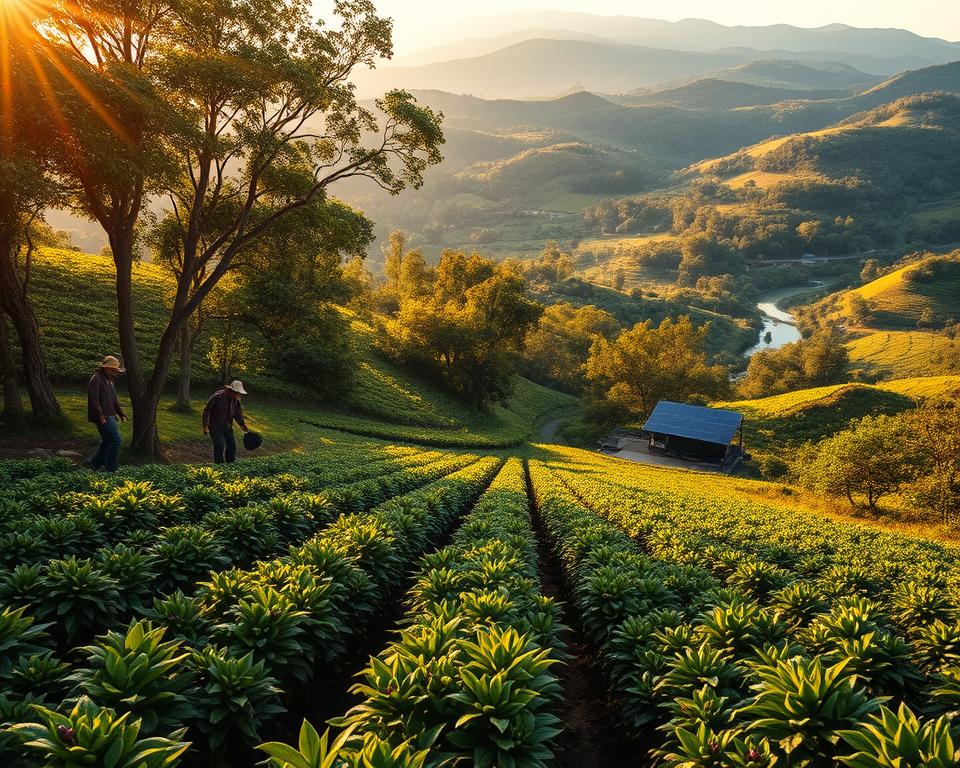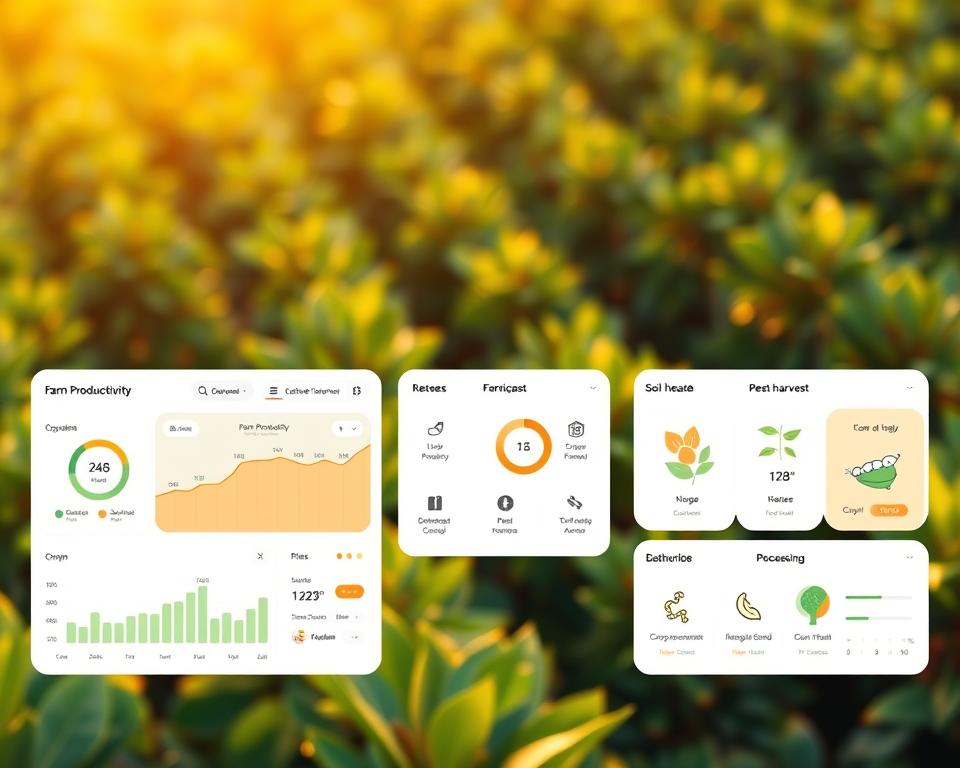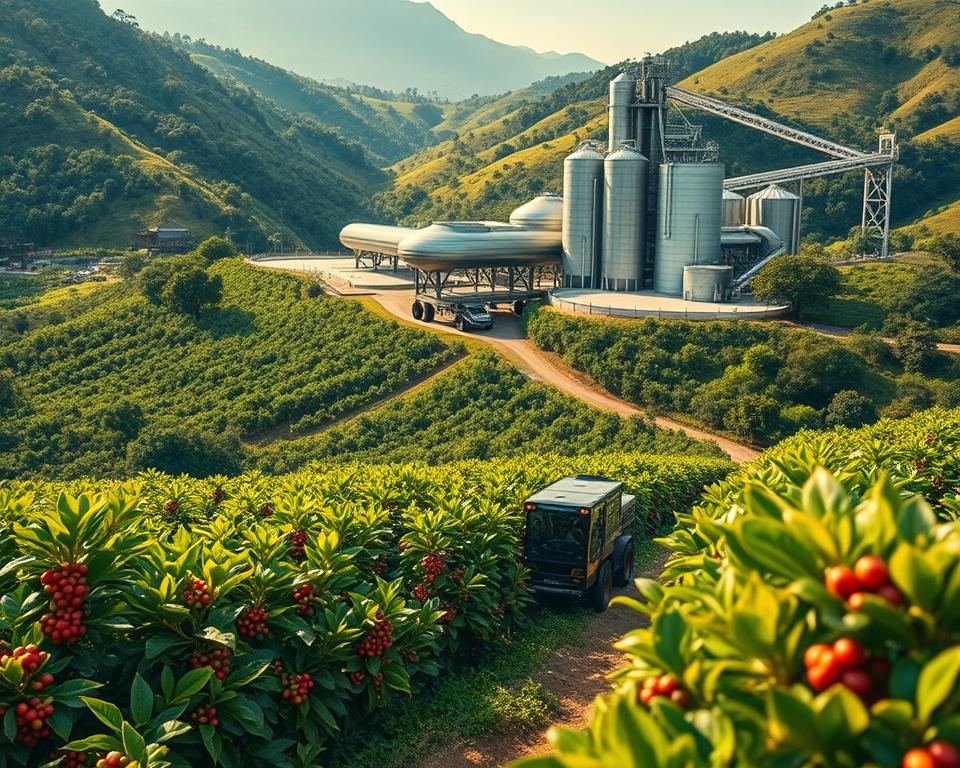Coffee farming and production are undergoing a tech-driven transformation. Every day, over 2.25 billion cups of coffee are consumed globally, driving demand for sustainable and high-quality beans. Innovations like AI-powered sorting machines and blockchain traceability are reshaping how coffee is grown, processed, and delivered. The industry has integrated AI since the 1990s, and now tools like drones, IoT sensors, and machine learning are addressing challenges like climate change and labor shortages.
Modern coffee production faces pressures from climate shifts and rising consumer expectations. Technologies like AI-enabled irrigation systems cut water use by 50%, while robotic harvesters in Vietnam boost efficiency. Smart coffee factories use IoT sensors to monitor real-time data, slashing waste and costs. These advancements promise better yields and ethical practices, aligning with global trends toward sustainability and transparency.
Key Takeaways
- AI sorting machines achieve 95% accuracy in bean quality control.
- Water-saving techniques reduce consumption by up to 50% in coffee farming.
- Blockchain ensures traceability, with 70% of consumers valuing clear sourcing details.
- Predictive analytics cut machine downtime by 30% through real-time monitoring.
- Smart coffee machines with AI learn user preferences, driving home brewing growth by 35% annually.
Introduction to Coffee Farming Technology
Coffee farming today ranges from ancient methods to cutting-edge innovations. Despite this, many farms globally, including those in South America and East Africa, still heavily rely on manual labor. Yet, even traditional farms are embracing technology, like weather sensors and irrigation systems, to boost their yields.
Overview of Current Practices
Smallholder farmers, who account for 80% of the world’s coffee, often employ hand tools and visual inspections for pests. In contrast, larger plantations use tractors for weeding and drones for monitoring crops. Key practices include:
- Manual harvesting in mountainous regions like Ethiopia
- Basic soil testing kits for nutrient management
- Shade-grown methods used in 25% of global production
“Climate change has cut yields by 15% in some coffee plantations since 2010.” — International Coffee Organization Report
Modern challenges, such as the coffee borer beetle and increasing temperatures, are compelling even traditional farms to adopt technology. For example, sensors in Colombian plantations track humidity to prevent fungal rust. This shift towards combining traditional knowledge with digital tools is a global trend. It aims to meet the market’s demands for quality and sustainability.
Precision Agriculture in Coffee Farming
Precision agriculture is revolutionizing coffee farming by leveraging data to make field-specific decisions. It merges technology with traditional coffee farming practices to enhance sustainability and profitability. By focusing on real-time data, farmers can reduce waste and environmental impact while improving bean quality.
Definition and Benefits
Precision agriculture employs sensors, drones, and AI to monitor soil, weather, and plant health. The benefits are substantial:
- Up to 30% less water use through smart irrigation
- 25% lower carbon emissions via optimized resource use
- Higher yields with 20-25% increases in production
These advantages stem from avoiding overuse of water and fertilizers, ensuring inputs are precisely matched to needs.
Tools Used in Precision Coffee Farming
Essential tools include:
- Soil sensors measuring moisture and nutrients
- Satellite imagery for field-wide analysis
- Drones scanning crops for pests or nutrient deficiencies
- AI platforms predicting harvest timing and disease risks
Farmers use these tools to create detailed maps, guiding planting, watering, and harvesting.
Case Studies of Success
Brazil’s Mió Coffee Farm, under COO Ana Luiza Pellicer, has significantly reduced water use by 30% while increasing yields. Their data-driven approach includes satellite imagery and soil analysis, cutting costs by 30% in two years. Colombian cooperatives have also seen a 25% reduction in fertilizer use through soil sensor networks.
“Precision agriculture turns guesswork into science,” says Pellicer. “Farmers now act on facts, not just experience.”
These innovations reflect a global trend—by 2030, 60% of specialty coffee farms aim to adopt precision methods. As climate challenges intensify, data-driven coffee farming techniques are becoming crucial for survival in an unpredictable market.
Automation and Mechanization in Coffee Harvesting
Automation is transforming coffee cherry collection, addressing labor shortages and enhancing quality. Robotic harvesters and AI tools are becoming common in major producers like Brazil. These innovations reduce waste and increase yields.
Types of Coffee Harvesting Machines
Modern systems are categorized into three types:
- Selective harvesters pick only ripe cherries, minimizing waste.
- Strip harvesters remove all beans at once, suitable for uniform climates.
- Semi-automated tools allow workers to guide machinery for precision.
Benefits of Automation for Farmers
Mechanization can cut labor costs by up to 60%, as seen in Brazil. The coffee production benefits include faster harvesting—8x quicker than manual methods—and safer work environments. The Case IH Coffee Express 200, tested by 35 Angolan and Ethiopian farmers, uses 1,248 nylon fingers to minimize plant damage.
“This machine could redefine coffee farming practices,” noted attendees at its launch. Farmers also see higher profits due to consistent bean quality, which commands premium prices. For post-harvest steps, guides like home roasting techniques help refine final products.
Future of Robotic Coffee Harvesting
“The technology employed by the Case IH Coffee Express aims to cut operational costs while raising yields,” the manufacturer states.
Prototypes now use AI to identify ripe cherries with 95% accuracy, and robotic arms mimic human dexterity. These tools could soon navigate uneven terrain, aiding smallholder farms. With global demand rising, expect autonomous systems to dominate plantations within five years, ensuring coffee production stays competitive.
Sustainability Trends in Coffee Farming
Sustainable coffee farming is transforming the industry, from cultivation to marketing. Shade-grown systems and organic farming lead to environmental and economic gains. Solar power and AI in water management are making farms more eco-friendly and profitable.

“Sustainability isn’t a choice—it’s essential for survival.”
— Starbucks’ C.A.F.E. Practices Team
Eco-friendly methods like agroforestry pair coffee with native trees, increasing biodiversity. Organic farming eschews synthetic chemicals, using composted coffee pulp and cover crops to improve soil health. These methods reduce costs and enhance flavor, aligning with global climate objectives.
- Certifications: Rainforest Alliance and Fair Trade labels ensure ethical labor and environmental standards.
- Consumer demand: 73% of U.S. consumers prefer sustainable brands, with many willing to pay premiums.
- Innovation: Nespresso’s AAA Program supports over 465,000 farms, reducing deforestation and improving yields.
Technologies like blockchain verify sustainability claims, while apps help farmers conserve water. Brands like Starbucks and Cooperativa de Caficultores de Antioquia show that ethical practices increase market access and farmer incomes. As climate threats escalate, embracing these trends is not just eco-conscious—it’s crucial for survival.
Blockchain Technology and Coffee Traceability
Blockchain is revolutionizing coffee farming practices by establishing transparent supply chains. It ensures every step of coffee production—from bean to brew—is documented securely. This allows farmers, buyers, and consumers to access verified data in real-time, building trust in ethical sourcing.
65% of specialty coffee drinkers are willing to pay more for fully traceable beans.
How Blockchain Works in Agriculture
Each coffee batch is assigned a digital ID on a shared ledger. Farmers record details like altitude and processing methods. Buyers track shipments, and retailers confirm certifications. This system minimizes fraud and delays, benefiting all parties involved.
Why Consumers Care
- Scan QR codes on bags to see a coffee’s journey
- Verify fair trade claims instantly
- Ensure organic and ethical certifications are accurate
Real-World Results
In Ethiopia, cooperatives using blockchain saw a 45% increase in farmer incomes by eliminating intermediaries. Debut Infotech’s CropChain platform, built on Hyperledger Fabric, simplifies traceability for global brands. Starbucks’ Costa Rican beans are now fully traceable via their app, validating sustainability claims. These innovations reduce costs and empower small-scale producers.
Data Analytics in Coffee Farming
Data analytics revolutionizes coffee cultivation by converting raw data into actionable insights. Farmers now leverage real-time data on soil health, weather, and plant behavior to enhance production. This evolution aligns with modern coffee farming guide practices, merging tradition with technology.
Role of Data Analytics in Crop Management
Advanced tools analyze soil moisture, temperature, and nutrient levels to optimize resource use. For instance, coffee farming guide platforms like ACCORD use GPS mapping and satellite data to target fertilizer applications. This approach reduces waste and enhances crop quality.
Predictive Analytics for Yield Improvement
- Predictive models forecast ripening dates with 90% accuracy, ensuring timely harvests.
- AI apps assess cherry ripeness, giving farmers objective quality scores to negotiate better prices.
- A partnership between DataKind and Carnegie Mellon University Africa created an app that cuts AI model size from 217MB to 8MB for easy mobile use.
Challenges and Solutions in Data Utilization
Smallholder farmers often face high costs and tech gaps. Solutions include:
- Cooperatives sharing analytics tools to reduce expenses
- Mobile apps with simplified interfaces for farmers
- Public-private partnerships funding access to platforms
“Accurate ripeness data empowers farmers to command fair prices,” says a TechnoServe report. “Tools like the cherry scoring system create transparency from farm to cup.”
Data-driven approaches in coffee cultivation also address climate risks. By analyzing historical trends, farmers adapt to weather shifts and disease risks proactively. This ensures sustainability and profitability, even for remote growers.
Climate-Smart Coffee Farming Techniques
Climate change poses a significant threat to coffee production. Yet, farmers are embracing coffee farming techniques to ensure their survival. They face the challenge of rising temperatures and unpredictable rainfall, necessitating innovative solutions to safeguard their livelihoods and the environment.
Adapting to Climate Change
Heat-tolerant coffee varieties, such as new Arabica hybrids, can thrive in temperatures 3-4°C higher than traditional strains. In Honduras and Guatemala, farmers are relocating their plantations to higher altitudes. They also employ intercropping to stabilize microclimates. Training initiatives, like Honduras’s Climate Pioneers, have empowered over 200 youth. A remarkable 86% of them now see opportunities in climate-resilient sustainable coffee farming.
“Adapt or disappear” – a mantra driving farmers to blend tradition with science.
Innovative Irrigation Systems
Subsurface drip irrigation significantly reduces water usage by 60%, focusing on root absorption. Sensors monitor plant stress, ensuring irrigation is only applied when necessary. Rainwater harvesting systems collect excess rainfall, mitigating drought risks. These innovations not only conserve resources but also enhance resilience.
Soil Health and Carbon Sequestration
Biochar, derived from coffee husks, enhances soil health by locking carbon into the soil. This improves fertility and water retention. Brazil could sequester 1.5M tons of carbon annually by utilizing half its coffee waste. Cover crops and composting reduce erosion and enrich soil. These practices transform farms into carbon sinks, benefiting both crops and the environment.
Mobile Applications for Coffee Farmers
Mobile apps are transforming coffee farming by making expert advice accessible to farmers. These tools, from diagnosing pests to tracking market prices, turn smartphones into essential resources for modern growers.

Essential Apps for Coffee Farming
- DFEMS (Digital Farm Extension Monitoring System): In Rwanda, this app tracks coffee tree data to optimize planting and harvest schedules. Funded by the EU, JDE Peet’s, and Rwanda’s government, it now serves over 400,000 farmers.
- Smart Kungahara System: Monitors fertilizer and seedling distribution nationwide, ensuring resources reach remote farms efficiently.
- Rainforest Alliance’s Farmer Training App: Offers 20+ interactive videos on sustainable practices, accessible offline for remote users.
Benefits of Technology on the Go
Apps provide coffee farming guide insights anytime, anywhere. Real-time weather alerts prevent crop losses, while market apps connect growers directly to buyers like JDE Peet’s, cutting out middlemen. Studies show app-guided fertilizer use reduces costs by 15–30%, boosting profits without sacrificing quality.
Case Studies of Successful App Usage
In Rwanda, the DFEMS pilot increased yields by 23% for smallholders by 2023. Guatemala’s coffee farmers using the Rainforest Alliance app adopted climate-smart techniques, raising yields and incomes. A Rwandan cooperative even averted $600,000 in losses during 2023’s volcanic ash crisis by using app alerts to protect crops.
Vertical Farming and Coffee Production
Urban coffee cultivation is evolving beyond traditional methods. Vertical farms, with their climate-controlled indoor systems, are revolutionizing coffee production. This innovation could help coffee growers face climate changes and space constraints.
- Water savings: Vertical setups recycle up to 95% of water, significantly reducing use compared to open-field coffee plantations.
- Year-round harvests eliminate seasonal limits, allowing farmers to sell fresh beans even during off-seasons.
- Space efficiency: A single vertical farm can match the output of 40 traditional acres in just 1 acre of urban space.
These systems also protect crops from pests and extreme weather. Yet, challenges persist. Energy costs for lighting and climate control are high. Coffee plants take 3–4 years to mature in vertical setups, slower than leafy greens. Current hydroponic setups often struggle with coffee’s long growth cycle.
But solutions are on the horizon. Startups in Singapore are testing LED lights tailored to coffee’s light needs, reducing energy use by 40%. Breeders are developing compact tree varieties for stacked layers. Solar panels and thermal systems are being explored to lower carbon footprints. Despite the challenges, vertical farms could open new markets. Urban locations near big cities reduce shipping costs, enabling farmers to access premium coffee markets directly.
Vertical coffee cultivation, though still in its experimental phase, holds promise for sustainability and resilience. As technology advances, these setups might become crucial for adapting to a warmer world.
The Future of Coffee Farming Technology
Climate change and shifting consumer tastes are transforming coffee farming. Innovations like CRISPR-edited crops and solar irrigation are changing the game. Organic farming and AI are crucial for the 2.25 billion cups enjoyed daily. Here’s a glimpse into the future.
Emerging Trends to Watch
CRISPR is being used to create coffee that can thrive in changing climates. Biofertilizers reduce chemical use by 80%. Drones and AI soil sensors are now common on forward-thinking farms.
Starbucks’ Nespresso AAA Sustainable Quality Program is a model for blending technology with tradition. Even small farmers are benefiting through initiatives like Ksapa’s SUTTI, which addresses funding and training needs.
Predictions for the Next Decade
By 2030, precision agriculture could cover 70% of mid-sized farms. Blockchain will track every bean’s journey, a requirement in the EU by 2026. Vertical farms in cities like Yunnan, China, might supply 5-10% of specialty coffee.
The IPCC warns that 50% of Arabica-friendly land could disappear by 2050. This highlights the need for urgent adoption of technology. Starbucks aims to make coffee fully traceable by 2030, a goal within reach.
FAQ
What are some important technological innovations in coffee farming?
How does precision agriculture benefit coffee farmers?
What are the main types of automatic coffee harvesting machines?
How are sustainable coffee farming practices being implemented?
What role does blockchain technology play in coffee production?
How can data analytics improve coffee farming?
What are the challenges posed by climate change to coffee farming?
How do mobile applications assist coffee farmers?
What advantages does vertical farming offer for coffee cultivation?
What are the predictions for the future of coffee farming technology?

Tina Avila is a writer at WyNeeds, where she delves into the rich and diverse world of coffee. With a passion for flavors and brewing techniques, she brings insightful articles covering everything from coffee culture and bean origins to expert tips on making the perfect cup. Her goal is to inspire and educate coffee enthusiasts, helping them enhance their appreciation for every sip.

